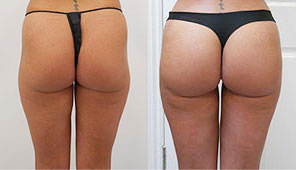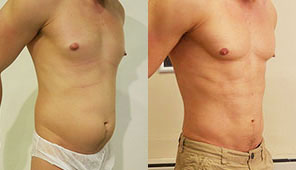Blepharoplasty
Offered at our convenient location in London

Blepharoplasty is an eyelid lift that will reduce excess skin above the eyes and brighten your whole appearance.
They say the eyes are the window to the soul, but those beautiful windows can be challenging for other people to see the older we get. The more we age, the more our eyelids start to sag and lose elasticity. As a result, they can make you look much older and tired. Luckily, there is hope.
Located conveniently on View Road, London, Dr. Grant Hamlet’s blepharoplasty procedures will help you look more dynamic and give you more confidence. Whether your reasons are medical or entirely cosmetic, blepharoplasty is a great way to look more youthful and vibrant. Successful blepharoplasty requires a full understanding of the eyelids’ anatomy, a meticulous preop evaluation, and precise attention to detail.[1] Since the area around the eyes is fragile and delicate, it’s essential to find a capable and competent surgeon, like our own Dr Grant, to perform this procedure. Please book a consultation with us now!
Contents
- 1 What Is An Eyelid Lift?
- 2 How Are Blepharoplasties Performed?
- 3 Reasons For Blepharoplasty
- 4 What Are “Bags”?
- 5 Types of Blepharoplasties
- 6 Techniques
- 7 Before Surgery
- 8 After Surgery
- 9 Benefits
- 10 Risks
- 11 Conditions That Can Exacerbate Risks
- 12 Are You The Right Candidate For Blepharoplasty?
- 13 References
What Is An Eyelid Lift?

The term “blepharoplasty” was first coined in 1818 by a German surgeon from Warsaw named Karl Ferdinand von Gräf. A blepharoplasty is a procedure used to correct any disfigurations, defects, or deformities of the eyelids. Somebody could also have one only for purely aesthetic modifications. This surgery helps people with bags under their eyes, wrinkles, fatty deposits, or saggy lower eyelids.
How Are Blepharoplasties Performed?
After cleaning and prepping the eyelids, the surgeon puts the patient under anaesthesia. If working on the upper lid, they will create an incision along the lid’s crease. If working on the lower lid, they will make an incision underneath the lower lash line. From there, the surgeon will rearrange and remove skin, fat, and muscle accordingly, making sure to smooth out the underlying eye muscles and toughen up the supporting structures. The surgeon will then proceed to reinforce the surrounding muscle and tendon tissues. Afterwards, the surgeon closes the incisions with either sutures or glue. The whole process takes about 2 to 3 hours. In about 1 to 2 weeks, after the initial swelling and bruising fade away, the patient is left looking younger and more vibrant.
Reasons For Blepharoplasty
- Puffy Eyes
- By removing excess fat and tightening the skin, our surgeons can make the eyes appear less puffy.
- Excess Skin on Lower Lids
- Extra skin on lower lids can cause sagging, dryness of the eyes, and wrinkles. Through a series of external incisions, our surgeon tightens the lids to create a smoother look overall.
- Droopy Eyelids
- Droopy eyelids can impair vision. Our surgeons treat this by incising the natural fold of the lid and then extracting the fat.
- Ptosis
- Ptosis is a more extreme and abnormal form of a droopy eyelid. Usually, a surgeon makes a minor adjustment to the lifting muscle. In more severe cases, they will have to strengthen the levator muscle (the muscle orbiting the upper eyelid) and reattach it to the eyelid.
- Lack of Upper Eyelid Folds
- Some people are born without any distinct eyelid fold lines. The procedure makes the lids tighter and more lifted to create a smoother, younger, yet subtle appearance.
What Are “Bags”?
Under-eye bags result from the fat that supports our eyes becoming weaker with age, causing the lower eyelids to sag or push forward, creating a swollen and puffy look. Some people are born with under-eye bags; others come into them later in life.
Unfortunately, excess fluids can also gather in the area below your eyes and create even more puffiness. Causes of under-eye fluid retention can include smoking, allergies, and a lack of sleep.
Types of Blepharoplasties
- Upper Eyelid – Is used to treat puffiness, drooping skin, or fat on the upper lids. This type of procedure is often performed on patients in their 50s and 60s.
- Lower Eyelid – Is used to treat bags under your eyes or excess skin on the lower lids.
- Double Eyelid – Is used to treat both sides of your eyelids. Many people opt for this treatment to look younger.
Techniques
- Transconjunctival Blepharoplasty – This is the most common blepharoplasty procedure. It does not require any stitches.
- Laser Blepharoplasty – Instead of a scalpel, a surgeon will opt for a laser. Patients usually get this procedure combined with laser eyelid rejuvenation.
Before Surgery
You’ll want to plan on getting somebody, a friend or family member, to drive you home after the procedure. If possible, have them stay with you the night of the surgery. They can help you move around as the swelling will impair your vision.
Things To Avoid Before Surgery
- Blood-thinning medications
- Smoking
After Surgery
It’s essential to take the steps that will allow your eyelids to heal most efficiently. Your surgeon will use a stitch type called a canthopexy by the eye’s outer corner inside the tissue after your procedure. This stitch helps keep your eyelid in a fixed position so that it will be able to heal correctly. Don’t worry; the stitches will dissolve in about 4 to 6 weeks.

It would be best if you planned on staying home from work and restricting your activity for three to four days. Your eyes will most likely have blurry vision and will be sensitive to light. Wear sunglasses for protection while outside.
Your doctor will provide medication for pain and a topical ointment to keep the area moist. He or she will also give you materials and instructions for cold compresses every 15-20 mins for the next 24 hrs after surgery. It would help if you also implemented eye drops to prevent dryness and infection.
When sleeping, you’ll also want to keep your head elevated to help decrease the swelling, so use 2 to 3 pillows if you can.
It will take approximately 2 to 3 months for you to heal up and experience the final results.
The procedure lasts up to at least 5 to 7 years. Your eyes will still naturally age even after the surgery. Should your eyes start to sag again, it would be preferable to get a forehead lift rather than another blepharoplasty.
Post-op, it would be advisable to suggest a patient undergo either a cataract or a refractive surgery since blepharoplasties can create overall vision changes.[2]
Items You Should Have Ready At Home
- Clean Towels and Washcloths
- Small Gauze Pads
- Ice Cubes
- Ice Pack
- Over-The-Counter Painkillers
- Avoid medications like aspirin, Advil, Motrin, Aleve, and Naproxen as they will increase your risk of bleeding. Talk to your doctor about recommendations.
What To Avoid While Your Eyelids Heal
- Full showers
- Wearing contact lenses
- Makeup and creams
Benefits
- Look Younger
- An eye lift affects your whole face for the better, making you look younger.
- Better Vision
- See clearer without excess skin obstructing your view.
- More Confidence
- Look good, feel good!
Risks
As with any surgical procedure, there are some risks involved. Although relatively safe, complications can still arise and range from simple skin changes to severe vision-threatening difficulties.[3] The following issues are not common, but it’s good to be aware of them and inform your doctor of any pre-existing conditions before surgery.
- Infection
- Dry eyes
- Bleeding
- Unable to fully close eyes
- Possible loss of vision
- Eyelids that fold in and out unnaturally
- A pulled-down lower lid lash line
- Irregular eyelid colouring
Should you experience any of the above symptoms, please reach out to your doctor as soon as possible.
Conditions That Can Exacerbate Risks
- Palpebral Skin Laxity
- Indicates looseness of the lower eyelid area. This can cause the lid to become malpositioned, creating a sarcastic eye-roll look.
- Dry-Eye Syndrome
- Dry-eye syndrome can worsen after a blepharoplasty due to the disruption of the eye’s natural “tear” film.
- Eyeball Prominence
- The bulging of the eye relative to the cheek can cause the lower eyelid to become malpositioned.
Are You The Right Candidate For Blepharoplasty?
An ideal candidate for this procedure would be someone over 18 years of age who has issues with sagging skin or fatty deposits either on their upper or lower eyelids.
People prone to eye infections or dry eyes are not ideal candidates, especially if they are smokers.
Please understand that blepharoplasties do not treat dark circles under the eyes, saggy eyebrows, or crows feet.
Do you think you would be the right candidate for blepharoplasty? Then book an appointment with us as soon as possible to consult with one of our doctors at our View Rd location.
Are you interested in what else we do at Dr. Grant Hamlet? Then please take a look at our blog, where you can find FAQs, testimonials, and other procedures that we provide.
References
- Biesman, Brian S. “Blepharoplasty.” Seminars in Cutaneous Medicine and Surgery, vol. 18, no. 2, 31 May 1999, pp. 129–138., doi:10.1016/s1085-5629(99)80037-6. https://europepmc.org/article/med/10385281
- Simsek, Ilke B, et al. “Effect of Upper Eyelid Blepharoplasty on Vision and Corneal Tomographic Changes Measured By Pentacam.” The International Journal on Orbital Disorders, Oculoplastic and Lacrimal Surgery, vol. 34, no. 5, 28 May 2015, pp. 263–267., doi:10.3109/01676830.2015.1057292. https://www.tandfonline.com/doi/abs/10.3109/01676830.2015.1057292
- Lisman, Richard D., and Gary J Lellie. “Blepharoplasty Complications.” Plastic and Reconstructive Surgery: Journal of the American Society of Plastic Surgeons, vol. 125, no. 3, Mar. 2010, pp. 1007–1017., doi:10.1097/PRS.0b013e3181ce17e8. https://journals.lww.com/plasreconsurg/Abstract/2010/03000/Blepharoplasty_Complications.32.aspx





